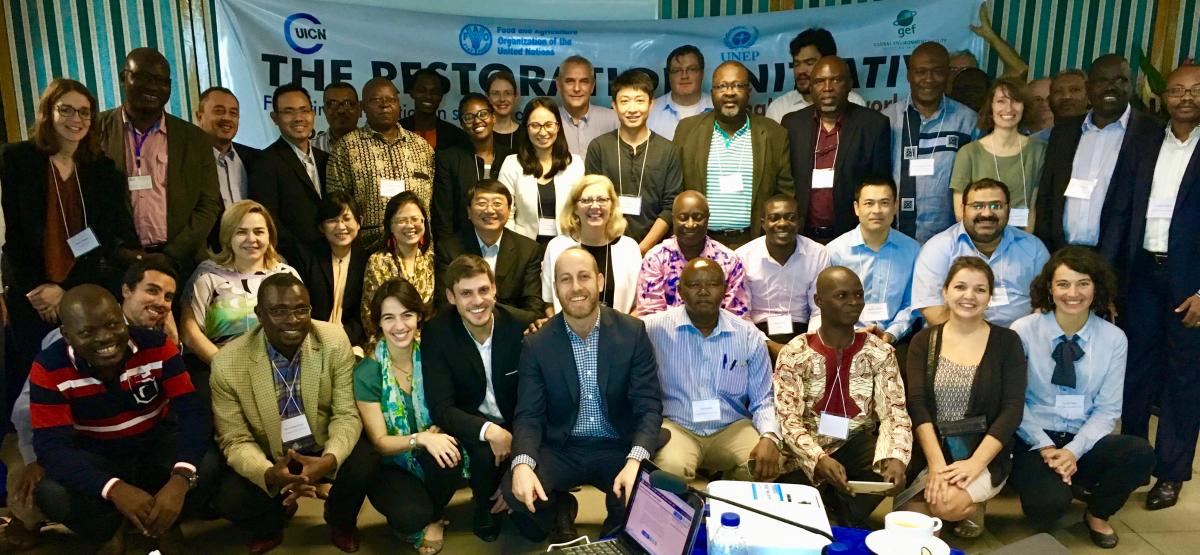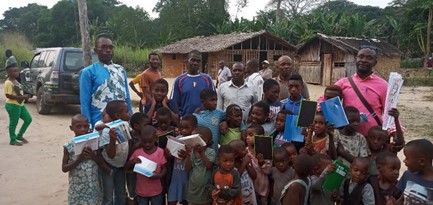Ten countries collaborate to kickstart restoration work
More than 50 representatives and project team members from 10 Asian and African countries gathered in Douala, Cameroon, last month to begin work on The Restoration Initiative (TRI) – an IUCN-led programme to help these countries define and achieve forest landscape restoration commitments under the Bonn Challenge. Josh Schneck, IUCN’s TRI Programme Manager, shares his positive outlook following the success of this meeting.

Shown from top left: Paola Palestini; Jouoguep Valery; Habtemariam Belay; Toe Toe Aung; Paul Psei-Tutu; Michel Disonama; Salah Marcel; Caroline Kabilu; Angela Joehl Cadena; Jing Liu; Christophe Besacier; An Sibo; Fred Stolle; Nelson Gomes Dias; Jacinto Coello; Hipolito Djata; Jean Claude Nguinguiri; Pierre Campredon; Jean Muneng; Peter Whaley; Salvador Pontes; Etienne Ngounio Gabia; Argentino Pires dos Santos; Second row from left: Valere Nzeyimana; Marietta Sakalian; Zin Myo Thu; Li Jia; Yang Chao; Carole Saint-Laurent; Desire Nagibona; Francisco Carranza; Kenechi Shono; Muhammad Afzal; Bottom row from left: Kenneth Angu; Gabriel Muturi; Mathilde Iweins; Gaetan Quesne; Josh Schneck; Paul Matiku; Denis Beina; Mirjam Kuzee; Lucille Palazy.
Photo: Jean Pierre Amayene, IUCN PACO
Supported in part by a $61 million commitment from the Global Environment Facility (GEF), the first phase of The Restoration Initiative (TRI) is focussed on building in-country project interventions that will together determine the critical landscapes, policies, financial mechanisms, and partnerships at the centre of countries’ restoration efforts.
The diversity of countries participating in TRI and the broad array of interventions supported present both opportunities and challenges in designing a cohesive, aligned programme. Therefore, a key component of the three-day workshop, which took place from 21 October through 2 November 2016, was to help participants elaborate how a programmatic approach will generate benefits beyond what can be achieved from stand-alone projects.
The Restoration Initiative
Approved by the GEF Council in June 2016, TRI is a programme to restore and maintain degraded and deforested landscapes at scale. Led by IUCN in partnership with the Food and Agricultural Organisation of the United Nations (FAO) and the United Nations Environment Programme (UNEP), the programme unites 10 partnering countries with the latest technical knowledge and innovative financing and decision-support tools, in support of the Bonn Challenge goal of restoring 150 million hectares worldwide by 2020 and 350 million hectares by 2030.
TRI at a glance
Partnering countries: Cameroon, Central African Republic, China, Democratic Republic of Congo, Guinea-Bissau, Kenya, Myanmar, Pakistan, Sao Tome and Principe, Tanzania
Partnering agencies: IUCN (lead agency); FAO; UNEP
Financing: $61 million in grants from the GEF; anticipated co-financing contributions of $200 million.
Approach: TRI will provide support for 4 types of broad interventions, each tailored to individual country needs and context, and that address key barriers to forest landscape restoration (FLR) at scale. They are:
- Policy identification and uptake – addressing the critical role that policies play in creating an enabling environment for FLR, TRI will provide support for country-led efforts to identify and integrate policy to incentivise and accelerate FLR.
- Implementation of FLR and complementary land management initiatives – providing support for the planning and implementation of on-ground FLR.
- Financing and Capacity building – providing support to unlock and mobilise domestic and external funding for FLR, and strengthening the ability of institutions to plan and manage FLR programmes.
- Knowledge sharing and partnerships – Support for sharing innovative experiences, raising awareness of FLR needs and benefits, and developing and strengthening critical partnerships.
Anticipated results: 1 million hectares of deforested and degraded landscapes restored; 46 million hectares of land under improved management incorporating biodiversity concerns; 190 million tons CO2eq sequestered.
Countries and project teams differ with respect to their familiarity with forest landscape restoration (FLR). For several TRI countries, including China, Pakistan and Kenya, restoration has been an integral part of policies governing forests and other state-managed lands for many years, while in others, restoration is a relatively new undertaking. Even for TRI countries with a comparatively long history of restoration, the terminology and approach to FLR supported by TRI, including the use of a landscape approach to balance competing needs and the many FLR decision-support tools and planning frameworks, may be new. This, along with similar findings from a post-workshop survey, emphasise the need for TRI to increase awareness and understanding on best-practice FLR, and the in-country benefits from and opportunities for restoration.
One of the most encouraging outcomes of the workshop – as evidenced by comments from participants at the close of the workshop and follow-up surveys – is the development of “programmatic thinking” among workshop participants. Attendees were keen explore the different ways countries can benefit from TRI, in particular through the profiling of country needs and opportunities in global, regional, and national fora to build momentum, influence policies, and attract additional financial support for FLR; through annual knowledge sharing events among TRI partners; and in accessing and developing capacity to use decision-support tools for restoration including the Restoration Opportunities Assessment Methodology (ROAM) developed by IUCN and the World Resources Institute (WRI).
As one attendee from Guinea Bissau stated, “being part of a global project supported by the GEF offers a real an opportunity to influence policy at the national level, but also in the other direction, to bring the voice of small countries like Guinea-Bissau to a global audience.”
Project development activities begin
The Douala workshop underscored both the enormous opportunity present in TRI but also the challenge of coordinating and designing a well-integrated programme across 10 countries with varying levels of familiarity with FLR, capacity, and unique interests and contexts. Delivering on TRI’s objective of catalysing restoration at scale requires that partners think several steps and several years ahead, to the types of outputs and results that are needed to deliver benefits at scale (e.g., case studies, policies, partnerships, information), and then coordinate project design efforts to ensure that projects deliver anticipated results and outcomes.
A sampling of development efforts includes Myanmar where, following the Douala workshop, a national-level workshop on FLR was held to increase understanding on FLR and ROAM, identify pressing needs including the need to define clear roles and responsibilities for FLR within the government, and identify how to fully integrate the TRI child project with Myanmar’s ten-year Restoration and Rehabiliatation programme. In China, pilot restoration activities supported by TRI are expected to inform ongoing efforts at reforming the management of State Forest Farms, potentially affecting some 45 million hectares of forested landscapes. And in Guinea-Bissau, interventions are focused on protecting and restoring mangroves and degraded lands to strengthen food security and provide climate mitigation benefits. Supporting these different national-level inteventions and ensuring that they inform and benefit from other TRI projects is the focus of the global support team.
While much work remains, the workshop was a milestone for TRI and a clear success – a post-workshop survey found that 88% of respondents (21/24) found the workshop very helpful to their work on TRI. Partners will be building upon this progress in Douala as they set about making TRI a reality on the ground for the people, forests and landscapes TRI will engage with.



